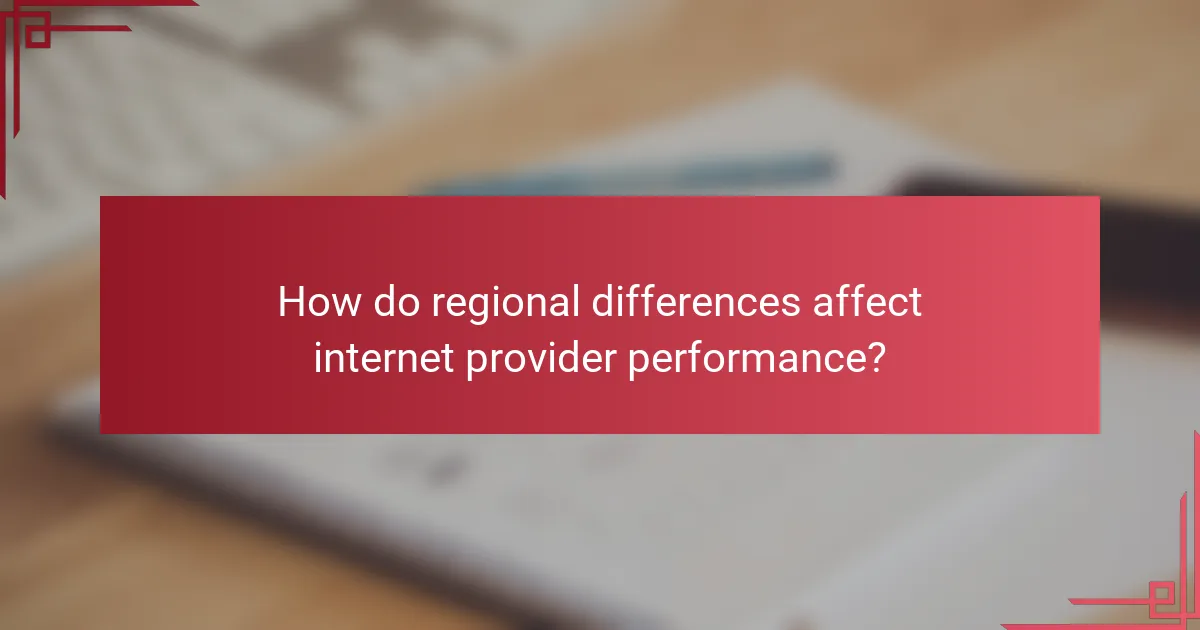When it comes to gaming performance, choosing the right internet provider is essential for achieving optimal speed and low latency. Fiber-optic services stand out as the top choice, delivering high-speed connections that ensure smooth gameplay and quick downloads. With lower latency, gamers can enjoy a more responsive and immersive experience, free from frustrating lag.

Which internet providers offer the best gaming performance in the US?
The best internet providers for gaming performance in the US typically offer high-speed connections with low latency. Key players include fiber-optic services, which deliver superior speeds and reliability, essential for an optimal gaming experience.
Verizon Fios
Verizon Fios is known for its fiber-optic network, providing speeds that can reach up to 940 Mbps. This high-speed connection results in low latency, often in the range of single-digit milliseconds, making it an excellent choice for gamers.
Additionally, Fios offers symmetrical upload and download speeds, which is beneficial for online gaming and streaming. It’s advisable to check availability in your area, as Fios is not nationwide.
AT&T Fiber
AT&T Fiber offers competitive speeds, with plans reaching up to 5 Gbps in select areas. This high bandwidth allows for seamless gaming experiences, especially in multiplayer scenarios where multiple devices are connected.
Latency levels are typically low, enhancing real-time interactions in games. Users should verify local availability, as coverage may vary significantly across regions.
Comcast Xfinity
Comcast Xfinity provides a range of internet plans, with speeds up to 1.2 Gbps. While not as consistently low in latency as fiber options, Xfinity still offers reasonable performance for gaming, usually around 20-30 ms.
One advantage of Xfinity is its widespread availability, making it accessible to many gamers. However, users should consider data caps on certain plans, which could impact heavy usage during gaming sessions.
Google Fiber
Google Fiber is renowned for its exceptional speeds, offering plans that can reach up to 2 Gbps. This service is ideal for gamers who require high-speed connections for both gaming and streaming.
With low latency, often under 10 ms, Google Fiber ensures a smooth gaming experience. However, it is limited to specific cities, so checking local availability is crucial.
CenturyLink
CenturyLink provides both DSL and fiber-optic internet, with fiber plans offering speeds up to 940 Mbps. While its DSL service may have higher latency, the fiber option is competitive for gaming.
CenturyLink’s pricing structure is straightforward, with no contracts required, allowing gamers to choose plans based on their needs. It’s important to assess the specific type of service available in your area to ensure optimal performance.

How does internet speed affect gaming experience?
Internet speed significantly impacts gaming performance, particularly in terms of responsiveness and update efficiency. Higher speeds and lower latency contribute to smoother gameplay and quicker downloads, enhancing the overall gaming experience.
Low latency for real-time action
Low latency, measured in milliseconds (ms), is crucial for real-time gaming, especially in fast-paced genres like first-person shooters and multiplayer online battle arenas. A latency of under 30 ms is generally considered excellent, while anything above 100 ms can lead to noticeable delays and affect gameplay.
To achieve low latency, choose internet providers that offer fiber-optic connections or cable services, as these typically provide faster response times compared to DSL or satellite options. Regularly testing your ping can help you monitor latency and ensure optimal performance during gaming sessions.
High download speeds for game updates
High download speeds are essential for quickly downloading game updates, patches, and new content. Speeds of at least 25 Mbps are recommended for a seamless experience, while faster connections can significantly reduce waiting times during updates.
When selecting an internet provider, consider plans that offer higher bandwidth to accommodate multiple devices and heavy usage. For example, a plan with speeds between 100-300 Mbps can support gaming, streaming, and browsing simultaneously without noticeable slowdowns.

What is the importance of latency in online gaming?
Latency is crucial in online gaming as it measures the delay between a player’s action and the game’s response. Lower latency results in smoother gameplay and a more immersive experience, while higher latency can lead to lag and frustration.
Impact on gameplay responsiveness
Gameplay responsiveness is directly affected by latency, as lower latency allows for quicker reactions to in-game events. For instance, a latency of under 20 milliseconds is generally considered optimal for fast-paced games, enabling players to execute commands almost instantaneously. In contrast, latencies exceeding 100 milliseconds can result in noticeable delays, impacting player performance.
Players should aim for internet connections that provide consistent low latency, as fluctuations can disrupt the gaming experience. Using wired connections instead of Wi-Fi can help maintain stable latency levels.
Effects on competitive gaming
In competitive gaming, latency can be a decisive factor that influences outcomes. Players in tournaments often require latencies below 30 milliseconds to ensure they can react faster than their opponents. Even slight delays can lead to missed opportunities or mistakes that could cost a match.
Many professional gamers invest in high-quality internet services that guarantee low latency and minimal packet loss. Choosing the right internet provider can make a significant difference in competitive scenarios, so players should research options that prioritize gaming performance.

How to choose the right internet plan for gaming?
Choosing the right internet plan for gaming involves evaluating speed, latency, and data management features. Prioritize plans that offer high speeds and low latency to ensure a smooth gaming experience.
Consider speed requirements
Speed is crucial for gaming, as it affects how quickly data is transmitted between your device and the game server. For most online games, a minimum download speed of 25 Mbps is recommended, while competitive gamers may benefit from speeds of 50 Mbps or higher.
When selecting a plan, consider the number of devices connected to your network. If multiple users are streaming or downloading content simultaneously, opt for higher speeds to avoid lag during gameplay.
Evaluate latency metrics
Latency, measured in milliseconds (ms), indicates the delay before data transfer begins. For gaming, a latency under 30 ms is ideal, while anything above 100 ms can lead to noticeable lag and negatively impact performance.
Check the provider’s latency ratings and consider using a wired connection, which typically offers lower latency compared to Wi-Fi. This can significantly enhance your gaming experience, especially in fast-paced games.
Assess data caps and throttling
Data caps limit the amount of data you can use each month, which can be problematic for gamers who download large updates or stream gameplay. Look for plans with no data caps or high thresholds to avoid interruptions.
Throttling occurs when an ISP intentionally slows down your connection after reaching a certain data limit. Review the terms of service to ensure your chosen plan does not include throttling, especially during peak hours when gaming performance is critical.

What are the top features to look for in gaming internet?
When selecting an internet provider for gaming, prioritize speed, low latency, and reliability. These features directly impact your gaming experience, affecting everything from loading times to responsiveness during gameplay.
Fiber-optic technology
Fiber-optic technology is often the best choice for gaming due to its high speeds and low latency. Unlike traditional copper connections, fiber-optic cables transmit data as light, allowing for faster and more stable connections.
With fiber-optic internet, gamers can expect download speeds often exceeding 100 Mbps, with latency typically in the low tens of milliseconds. This combination minimizes lag and enhances real-time interactions in online games.
Dedicated gaming plans
Dedicated gaming plans are tailored specifically for gamers, offering prioritized bandwidth and lower latency. These plans often come with features like Quality of Service (QoS) settings, which ensure that gaming traffic is prioritized over other types of internet use.
When considering a dedicated gaming plan, look for options that provide consistent speeds, even during peak usage times. Some providers may offer plans with speeds ranging from 50 Mbps to 1 Gbps, allowing for seamless multiplayer experiences.

How do regional differences affect internet provider performance?
Regional differences significantly impact internet provider performance, particularly in terms of speed, latency, and reliability. Urban areas typically enjoy better infrastructure and more options, while rural regions often face limited availability and slower connections.
Urban vs rural availability
In urban areas, internet providers compete vigorously, leading to a variety of high-speed options, including fiber-optic connections. This competition often results in lower prices and better service quality for consumers.
Conversely, rural areas frequently have fewer providers, which can limit choices and lead to higher prices. Many rural residents rely on satellite or DSL services, which may offer slower speeds and higher latency compared to urban fiber connections.
When choosing an internet provider, consider your location’s availability and the types of connections offered. If you live in a rural area, check for local initiatives that may improve internet access, such as government subsidies or community broadband projects.



